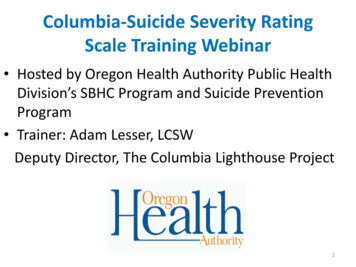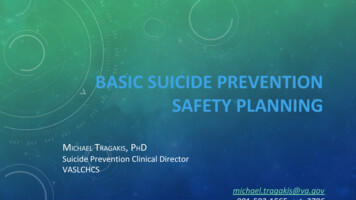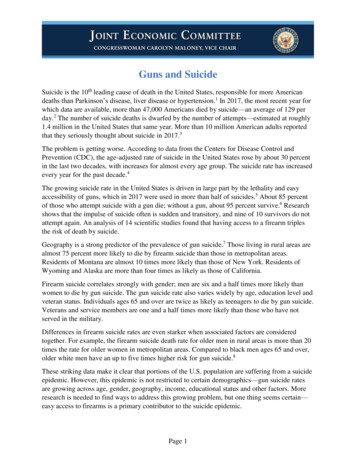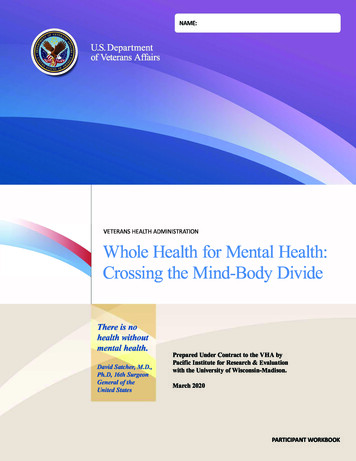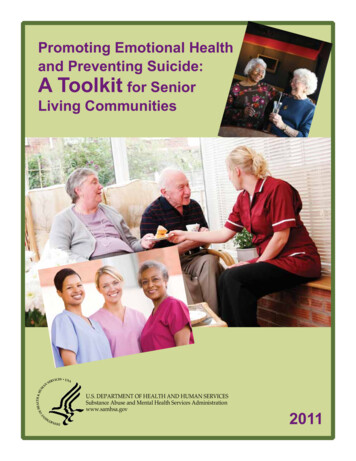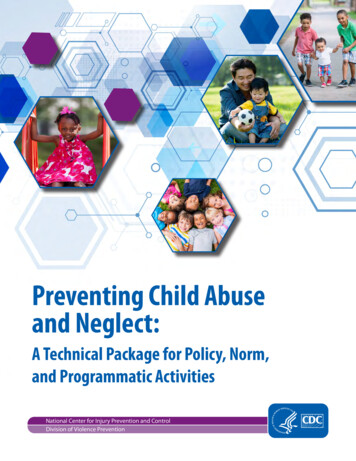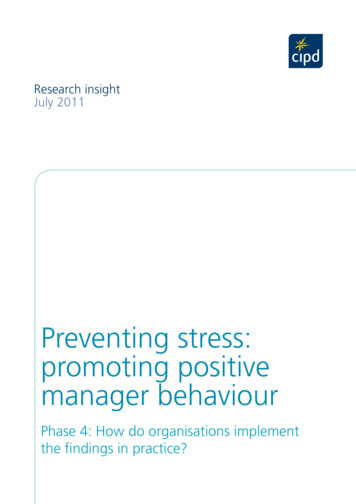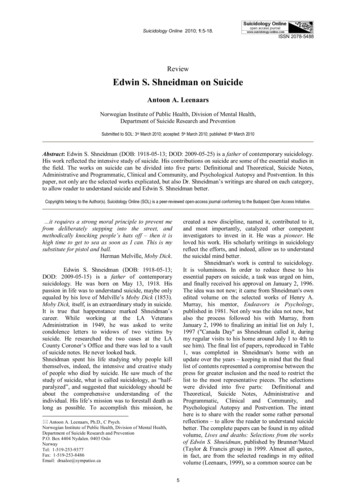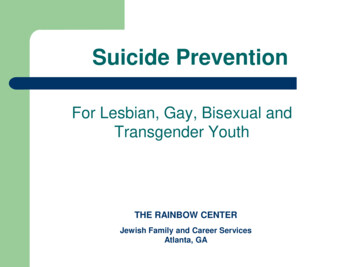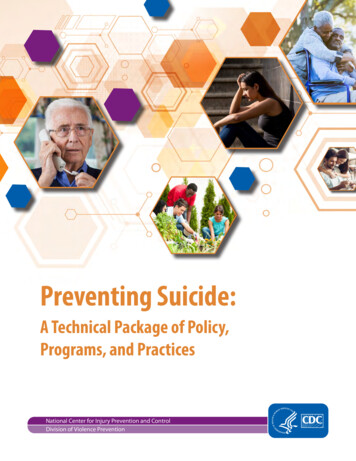
Transcription
Preventing Suicide:A Technical Package of Policy,Programs, and PracticesNational Center for Injury Prevention and ControlDivision of Violence Prevention
Preventing Suicide:A Technical Package of Policy,Programs, and PracticesDeveloped by:Deb Stone, ScD, MSW, MPHKristin Holland, PhD, MPHBrad Bartholow, PhDAlex Crosby, MD, MPHShane Davis, PhDNatalie Wilkins, PhD2017Division of Violence PreventionNational Center for Injury Prevention and ControlCenters for Disease Control and PreventionAtlanta, Georgia
Centers for Disease Control and PreventionAnne Schuchat, MD (RADM, USPHS), Acting DirectorNational Center for Injury Prevention and ControlDebra E. Houry, MD, MPH, DirectorDivision of Violence PreventionJames A. Mercy, PhD, DirectorSuggested citation:Stone, D.M., Holland, K.M., Bartholow, B., Crosby, A.E., Davis, S., and Wilkins, N. (2017).Preventing Suicide: A Technical Package of Policies, Programs, and Practices. Atlanta, GA:National Center for Injury Prevention and Control, Centers for Disease Control andPrevention.2Preventing Suicide: A Technical Package of Policy, Programs, and Practices
ContentsAcknowledgements. 5External Reviewers. 5Overview. 7Strengthen Economic Supports.15Strengthen Access and Delivery of Suicide Care.19Create Protective Environments .23Promote Connectedness.27Teach Coping and Problem-Solving Skills.31Identify and Support People at Risk.35Lessen Harms and Prevent Future Risk.41Sector Involvement.43Monitoring and Evaluation.45Conclusion.47References.49Appendix: Summary of Strategies and Approaches to Prevent Suicide.58Preventing Suicide: A Technical Package of Policy, Programs, and Practices3
AcknowledgementsWe would like to thank the following individuals who contributed in specific ways to the development of this technicalpackage. We give special thanks to Linda Dahlberg for her vision, guidance, and support throughout the developmentof this package. We thank Division, Center, and CDC leadership for their careful review and helpful feedback on earlieriterations of this document. We thank Alida Knuth for her formatting and design expertise. Last but definitely not least,we extend our thanks and gratitude to all the external reviewers for their helpful feedback, support and encouragementfor this resource.External ReviewersCasey CastaldiPrevention InstituteDoreen S. MarshallAmerican Foundation for Suicide PreventionCarmen ClellandOffice for State, Tribal, Local and Territorial Support,Centers for Disease Control and PreventionChristine MoutierAmerican Foundation for Suicide PreventionJason H. PadgettEducation Development Center, Inc.Amalia Corby-EdwardsAmerican Psychological AssociationJerry ReedEducation Development Center, Inc.Rachel DavisPrevention InstituteDan ReidenbergSuicide Awareness Voices for Education (SAVE)Pamela End of HornIndian Health Service HeadquartersCraig FisherAmerican Psychological AssociationChristine SchulerNational Institute for Occupational Safety and Health,Centers for Disease Control and PreventionKeita FranklinDepartment of DefenseMorton SilvermanEducation Development Center, Inc.Jill M. Harkavy FriedmanAmerican Foundation for Suicide PreventionEllyson StoutEducation Development Center, Inc.Jarrod HindmanColorado Department of Public Health and EnvironmentHope M. TiesmanNational Institute for Occupational Safety and Health,Centers for Disease Control and PreventionLinda LangfordEducation Development Center, Inc.Richard McKeonSubstance Abuse and Mental Health Services AdministrationThe experts above are listed with their affiliations at the time this document was reviewed.Preventing Suicide: A Technical Package of Policy, Programs, and Practices5
OverviewThis technical package represents a select group of strategies based on the best available evidence to helpcommunities and states sharpen their focus on prevention activities with the greatest potential to prevent suicide.These strategies include: strengthening economic supports; strengthening access and delivery of suicide care;creating protective environments; promoting connectedness; teaching coping and problem-solving skills; identifyingand supporting people at risk; and lessening harms and preventing future risk. The strategies represented in thispackage include those with a focus on preventing the risk of suicide in the first place as well as approaches to lessenthe immediate and long-term harms of suicidal behavior for individuals, families, communities, and society. Thestrategies in the technical package support the goals and objectives of the National Strategy for Suicide Prevention1and the National Action Alliance for Suicide Prevention’s priority to strengthen community-based prevention.2Commitment, cooperation, and leadership from numerous sectors, including public health, education, justice, healthcare, social services, business, labor, and government can bring about the successful implementation of this package.What is a Technical Package?A technical package is a compilation of a core set of strategies to achieve and sustain substantial reductions in aspecific risk factor or outcome.3 Technical packages help communities and states prioritize prevention activities basedon the best available evidence. This technical package has three components. The first component is the strategy orthe preventive direction or actions to achieve the goal of preventing suicide. The second component is the approach.The approach includes the specific ways to advance the strategy. This can be accomplished through programs, policies,and practices. The evidence for each of the approaches in preventing suicide or its associated risk factors is includedas the third component. This package is intended as a resource to guide and inform prevention decision-making incommunities and states.Preventing Suicide is a PrioritySuicide, as defined by the Centers for Disease Control and Prevention (CDC), is part of a broader class of behaviorcalled self-directed violence. Self-directed violence refers to behavior directed at oneself that deliberately results ininjury or the potential for injury.4 Self-directed violence may be suicidal or non-suicidal in nature. For the purposes ofthis document, we refer only to behavior where suicide is intended: Suicide is a death caused by self-directed injurious behavior with any intent to die as a result of the behavior. Suicide attempt is defined as a non-fatal self-directed and potentially injurious behavior with any intent todie as a result of the behavior. A suicide attempt may or may not result in injury.Suicide is highly prevalent. Suicide presents a major challenge to public health in the United States and worldwide.It contributes to premature death, morbidity, lost productivity, and health care costs.1,5 In 2015 (the most recent yearof available death data), suicide was responsible for 44,193 deaths in the U.S., which is approximately one suicideevery 12 minutes.6 In 2015, suicide ranked as the 10th leading cause of death and has been among the top 12 leadingcauses of death since 1975 in the U.S.7 Overall suicide rates increased 28% from 2000 to 2015.6 Suicide is a problemthroughout the life span; it is the third leading cause of death for youth 10–14 years of age, the second leading causeof death among people 15–24 and 25–34 years of age; the fourth leading cause among people 35 to 44 years of age,the fifth leading cause among people ages 45–54 and eighth leading cause among people 55–64 years of age.6Preventing Suicide: A Technical Package of Policy, Programs, and Practices7
Suicide rates vary by race/ethnicity, age, and other populationcharacteristics, with the highest rates across the life span occurringamong non-Hispanic American Indian/Alaska Native (AI/AN) andnon-Hispanic White population groups. In 2015, the rates for thesegroups were 19.9 and 16.9 per 100,000 population, respectively.6Other population groups disproportionately impacted by suicideinclude middle-aged adults (whose rates increased 35% from2000 to 2015, with steep increases seen among both males (29%)and females (53%) aged 35–64 years6; Veterans and other militarypersonnel (whose suicide rate nearly doubled from 2003 to 2008,surpassing the rate of suicide among civilians for the first time indecades)8,9; workers in certain occupational groups,10,11 and sexualminority youth, who experience increased suicidal ideation andbehavior compared to their non-sexual minority peers.12-14Suicides reflect only a portion of the problem.15 Substantially morepeople are hospitalized as a result of nonfatal suicidal behavior(i.e., suicide attempts) than are fatally injured, and an even greaternumber are either treated in ambulatory settings (e.g., emergencydepartments) or not treated at all.15 For example, during 2014,among adults aged 18 years and older, for every one suicide therewere 9 adults treated in hospital emergency departments for selfharm injuries, 27 who reported making a suicide attempt, andover 227 who reported seriously considering suicide.6,16Suicide is associated with several risk and protective factors. Suicide, like other human behaviors, has nosingle determining cause. Instead, suicide occurs in response to multiple biological, psychological, interpersonal,environmental and societal influences that interact with one another, often over time.1,5 The social ecologicalmodel—encompassing multiple levels of focus from the individual, relationship, community, and societal—is a usefulframework for viewing and understanding suicide risk and protective factors identified in the literature.17 Risk andprotective factors for suicide exist at each level. For example, risk factors include:1,5 Individual level: history of depression and other mental illnesses, hopelessness, substance abuse, certainhealth conditions, previous suicide attempt, violence victimization and perpetration, and genetic andbiological determinants Relationship level: high conflict or violent relationships, sense of isolation and lack of social support, family/loved one’s history of suicide, financial and work stress Community level: inadequate community connectedness, barriers to health care (e.g., lack of access toproviders and medications) Societal level: availability of lethal means of suicide, unsafe media portrayals of suicide, stigma associatedwith help-seeking and mental illness.It is important to recognize that the vast majority of individuals who are depressed, attempt suicide, or have other riskfactors, do not die by suicide.18,19 Furthermore, the relevance of each risk factor can vary by age, race, gender, sexualorientation, residential geography, and socio-cultural and economic status.1,58Preventing Suicide: A Technical Package of Policy, Programs, and Practices
Exposure to violenceis associated withincreased risk ofdepression, post-traumaticstress disorder (PTSD),anxiety, suicide, andsuicide attempts.Protective factors, or those influences that buffer against the risk for suicide, can also be found across the differentlevels of the social ecological model. Protective factors identified in the literature include: effective coping andproblem-solving skills, moral objections to suicide, strong and supportive relationships with partners, friends, andfamily; connectedness to school, community, and other social institutions; availability of quality and ongoing physicaland mental health care, and reduced access to lethal means.1,5 These protective factors can either counter a specificrisk factor or buffer against a number of risks associated with suicide.Suicide is connected to other forms of violence. Exposure to violence (e.g., child abuse and neglect, bullying,peer violence, dating violence, sexual violence, and intimate partner violence) is associated with increased risk ofdepression, post-traumatic stress disorder (PTSD), anxiety, suicide, and suicide attempts.20-26 Women exposed topartner violence are nearly 5 times more likely to attempt suicide as women not exposed to partner violence.26Exposure to adverse experiences in childhood, such as physical, sexual, emotional abuse and neglect, and living inhomes with violence, mental health, substance abuse problems and other instability, is also associated with increasedrisk for suicide and suicide attempts.22,27 The psychosocial effects of violence in childhood and adolescence can beobserved decades later, including severe problems with finances, family, jobs, and stress—factors that can increasethe risk for suicide. Suicide and other forms of violence often share the same individual, relationship, community,and societal risk factors suggesting that efforts to prevent interpersonal violence may also prove beneficial inpreventing suicide.28-30 CDC has developed technical packages for the different forms of interpersonal violence to helpcommunities identify additional strategies and approaches calpackages.html). Further, just as risk factors may be shared across suicide and interpersonal violence, so too mayprotective factors overlap. For example, connectedness to one’s community,31 school,32 family,33 caring adults,34,35 andpro-social peers36 can enhance resilience and help reduce risk for suicide and other forms of violence.Preventing Suicide: A Technical Package of Policy, Programs, and Practices9
The health and economic consequences of suicide are substantial. Suicideand suicide attempts have far reaching consequences for individuals, families,and communities.37-40 In an early study, Crosby and Sacks41 estimated that7% of the U.S. adult population, or 13.2 million adults, knew someone in theprior 12 months who had died by suicide. They also estimated that for eachsuicide, 425 adults were exposed, or knew about the death.41 In a more recentstudy, in one state, Cerel et al42 found that 48% of the population knew atleast one person who died by suicide in their lifetime. Research indicatesthat the impact of knowing someone who died by suicide and/or havinglived experience (i.e., personally have attempted suicide, have had suicidalthoughts, or have been impacted by suicidal loss) is much more extensivethan injury and death. People with lived experience may suffer long-termhealth and mental health consequences ranging from anger, guilt, andphysical impairment, depending on the means and severity of the attempt.43Similarly, survivors of a loved one’s suicide may experience ongoing pain andsuffering including complicated grief,44 stigma, depression, anxiety, posttraumatic stress disorder, and increased risk of suicidal ideation and suicide.45,46Less discussed but no less important, are the financial and occupationaleffects on those left behind.47The economic toll of suicide on society is immense as well. According to conservative estimates, in 2013, suicide cost 50.8 billion in estimated lifetime medical and work-loss costs alone.47 Adjusting for potential under-reporting ofsuicide and drawing upon health expenditures per capita, gross domestic product per capita, and variability amongstates in per capita health care expenditures and income, another study estimated the total lifetime costs associatedwith nonfatal injuries and deaths caused by self-directed violence to be approximately 93.5 billion in 2013.48 Theoverwhelming burden of these costs were from lost productivity over the life course, with the average cost persuicide being over 1.3 million.48 The true economic costs are likely higher, as neither study included monetaryfigures related to other societal costs such as those associated with the pain and suffering of family members orother impacts.Suicide can be prevented. Like most public health problems, suicide is preventable.1,5 While progress will continueto be made into the future, evidence for numerous programs, practices, and policies currently exists, and manyprograms are ready to be implemented now. Just as suicide is not caused by a single factor, research suggests thatreductions in suicide will not be prevented by any single strategy or approach.1,49 Rather, suicide prevention is bestachieved by a focus across the individual, relationship, family, community, and societal-levels and across all sectors,private and public.1,5Assessing the EvidenceThis technical package includes programs, practices, and policies with evidence of impact on suicide or risk orprotective factors for suicide. To be considered for inclusion in the technical package, the program, practice, orpolicy selected had to meet at least one of these criteria: a) meta-analyses or systematic reviews showing impacton suicide; b) evidence from at least one rigorous (e.g., randomized controlled trial [RCT] or quasi-experimentaldesign) evaluation study that found significant preventive effects on suicide; c) meta-analyses or systematic reviewsshowing impact on risk or protective factors for suicide, or d) evidence from at least one rigorous (e.g., RCT or quasiexperimental design) evaluation study that found significant impacts on risk or protective factors for suicide. Finally,consideration was also given to the likelihood of achieving beneficial effects on multiple forms of violence; noevidence of harmful effects on specific outcomes or with particular subgroups; and feasibility of implementation in aU.S. context if the program, policy, or practice has been evaluated in another country.10Preventing Suicide: A Technical Package of Policy, Programs, and Practices
Within this technical package, some approaches do not yet have research evidence demonstrating impact on rates ofsuicide but instead are supported by evidence indicating impacts on risk or protective factors for suicide (e.g., helpseeking, stigma reduction, depression, connectedness). In terms of the strength of the evidence, programs that havedemonstrated effects on suicidal behavior (e.g., reductions in deaths, attempts) provide a higher-level of evidence,but the evidence base is not that strong in all areas. For instance, there has been less evaluation of communityengagement and family programs on suicidal behavior. Thus, approaches in this package that have effects on risk orprotective factors reflect the developing nature of the evidence base and the use of the best available evidence at agiven time.It is also important to note that there is often significant heterogeneity among the programs, policies, or practices thatfall within one approach or strategy in terms of the nature and quality of the available evidence. Not all programs, policies, or practices that utilize the same approach are equally effective, and even those that are effective may not workacross all populations. Tailoring programs and conducting more evaluations may be necessary to address differentpopulation groups. The evidence-based programs, practices, or policies included in the package are not intended tobe a comprehensive list for each approach, but rather to serve as examples that have been shown to impact suicide orhave beneficial effects on risk or protective factors for suicide.Contextual and Cross-Cutting ThemesOne important feature of the package is the complementary and potentially synergistic impact of the strategies andapproaches. The strategies and approaches included in this technical package represent different levels of the socialecology, with efforts intended to impact community and societal levels, as well individual and relationship levels.The strategies and approaches are intended to work in combination and reinforce each other to prevent suicide (seebox on page 12). The strategies are arranged in order such that those strategies hypothesized to have the greatestpotential for broad public health impact on suicide are included first, followed by those that might impact subsets ofthe population (e.g., persons who have already made a suicide attempt).Like mostpublic healthproblems,suicide ispreventable.Preventing Suicide: A Technical Package of Policy, Programs, and Practices11
Preventing SuicideStrategyApproachStrengthen economic supports Strengthen household financial security Housing stabilization policiesStrengthen access and deliveryof suicide care Coverage of mental health conditions in health insurance policies Reduce provider shortages in underserved areas Safer suicide care through systems changeCreate protective environments Reduce access to lethal means among persons at risk of suicide Organizational policies and culture Community-based policies to reduce excessive alcohol usePromote connectedness Peer norm programs Community engagement activitiesTeach coping andproblem-solving skills Social-emotional learning programs Parenting skill and family relationship programsIdentify and supportpeople at risk Lessen harms and preventfuture risk Postvention Safe reporting and messaging about suicideGatekeeper trainingCrisis interventionTreatment for people at risk of suicideTreatment to prevent re-attemptsIt is important to note that these strategies are not mutually exclusive but each has an immediate focus. For instance,social-emotional learning programs, an approach under the Teach Coping and Problem-Solving Skills strategy,sometimes include components to change peer norms and the broader environment. The primary focus of theseprograms, however, is to provide children and youth with skills to resolve problems in relationships, school, and withpeers, and to help youth address other negative influences (e.g., substance use) associated with suicide.12Preventing Suicide: A Technical Package of Policy, Programs, and Practices
The goal of this package is to stress the importance of comprehensive prevention efforts and to provide examples ofeffective programs addressing each level of the social ecology, with the knowledge that some programs, practices,and policies may impact multiple levels. Further, those that involve multiple sectors and that impact multiple levels ofthe social ecology are more likely to have a greater impact on the overall burden of suicide.Suicide ideation, thoughts, attempts, and deaths vary by gender, race/ethnicity, age, occupation, and other importantpopulation characteristics.6,50 Further, certain transition periods are also associated with higher rates of suicide (e.g.,transition from working into retirement, transition from active duty military status to civilian status).48,51 In fact, suiciderisk can change along with dynamic risk factors. For example, individuals’ coping skills may change during periods ofcrisis and heightened stress, limiting their normal ability to effectively solve problems and cope. Research indicatesthat suicide risk changes as a result of the number and intensity of key risk and protective factors experienced.52Ideally, the availability of multiple strategies and approaches tailored to the social, economic, cultural, andenvironmental context of individuals and communities are desirable as they may increase the likelihood of removingbarriers to supportive and effective care and provide opportunities to develop individual and community resilience.1Identifying programs, practices, and policies with evidence of impact on suicide, suicide attempts, or beneficial effectson risk or protective factors for suicide is only the first step. In practice, the effectiveness of the programs, policiesand practices identified in this package will be strongly dependent on how well they are implemented, as well as thepartners and communities in which they are implemented. Practitioners in the field may be in the best position toassess the needs and strengths of their communities and work with community members to make decisions about thecombination of approaches included here that are best suited to their context.Data-driven strategic planning processes can help communities with this work.53-55 These planning processes engageand guide community stakeholders through a prevention planning process designed to address a community’s profileof risk and protective factors with evidence-based programs, practices, and policies. These processes can also be usedto monitor implementation, track outcomes, and make adjustments as indicated by the data. The readiness of theprogram for broad dissemination and implementation (e.g., availability of program materials, training and technicalassistance) can also influence program effects. Implementation guidance to assist practitioners, organizations andcommunities will be developed separately.This package includes strategies where public health agencies are well positioned to bring leadership and resourcesto implementation efforts. It also includes strategies where public health can serve as an important collaborator (e.g.,strategies addressing community and societal level risks), but where leadership and commitment from other sectorssuch as business, labor or health care is critical to implement a particular policy or program (e.g., workplace policies;treatment to prevent re-attempts). The role of various sectors in the implementation of a strategy or approach inpreventing suicide is described further in the section on Sector Involvement.In the sections that follow, the strategies and approaches with the best available evidence for preventing suicideare described.Preventing Suicide: A Technical Package of Policy, Programs, and Practices13
Strengthen Economic SupportsRationaleStudies from the U.S. examining historical trends indicate that suicide rates increase during economic recessionsmarked by high unemployment rates, job losses, and economic instability and decrease during economicexpansions and periods marked by low unemployment rates, particularly for working-age individuals 25 to 64 yearsold.56,57 Economic and financial strain, such as job loss, long periods of unemployment, reduced income, difficultycovering medical, food, and housing expenses, and even the anticipation of such financial stress may increasean individual’s risk for suicide or may indirectly increase risk by exacerbating related physical and mental healthproblems.58 Buffering these risks can, therefore, potentially protect against suicide. For example, strengtheningeconomic support systems can help people stay in their homes or obtain affordable housing while also payingfor necessities such as food and medical care, job training, child care, among other expenses required for dailyliving. In providing this support, stress and anxiety and the potential for a crisis situation may be reduced, therebypreventing suicide. Although more research is needed to understand how economic factors interact with otherfactors to increase suicide risk, the available evidence suggests that strengthening economic supports may be oneopportunity to buffer suicide risk.ApproachesEconomic supports for individuals and families can be strengthened by targeting household financial security andensuring stability in housing during periods of economic stress.Strengthening household financial security can potentially buffer the risk of suicide by providing individualswith the financial means to lessen the stress and hardship associated with a job loss or other unanticipated financialproblems. The provision of unemployment benefits and other forms of temporary assistance, livable wages, medicalbenefits, and retirement and disability insurance to help cover the cost of necessities or to offset costs in the event ofdisability, are examples of ways to strengthen household financial security.Housing stabilization policies aim to keep people in their homes and provide housing options for those inneed during times of financial insecurity. This may occur through programs that provide affordable housingsuch as through government subsidies or through other options available to potential homebuyers such as loanmodification programs, move-out planning, or financial counseling services that help minimize the risk or impact offoreclosures and eviction.Potential Outcomes Reductions in foreclosure rates Reductions in eviction rates Reductions in emotional distress Reductions in rates of suicidePreventing Suicide: A Technical Package of Policy, Programs, and Practices15
EvidenceThere is evidence sugge
depression, post-traumatic stress disorder (PTSD), anxiety, suicide, and suicide attempts.20-26 Women exposed to partner violence are nearly 5 times more likely to attempt suicide as women not exposed to partner violence.26 Exposure to adverse experiences in childhood, such as physical, sexual, emotional abuse and neglect, and living in

